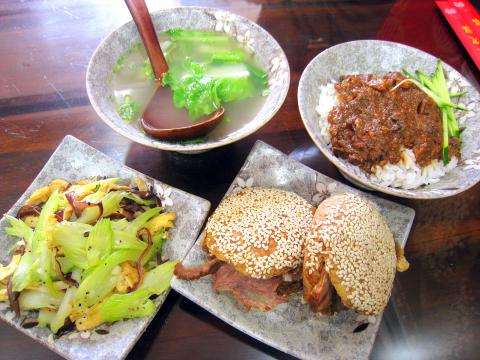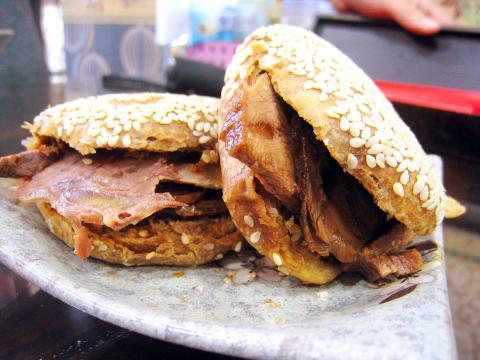Uncle Ma’s Shaobing Shop (馬叔餅鋪) started life as little more than a stall off Taipei’s Jinshan South Road (金山南路) selling traditional Beijing-style sesame shaobing (芝麻燒餅), a dense flatbread popular in northern China. Opened in 1949, Uncle Ma’s moved to a new location last month and upgraded to a cozy sit-down restaurant that serves a variety of Beijing specialties.
The restaurant has the look of a conventional beef noodle establishment, and it has indeed added this Taiwan staple to its menu (NT$120). But the highlight of a meal at Uncle Ma’s remains its shaobing. It first needs to be pointed out that these shaobing, while a distant relative to the familiar variety available at traditional soy milk breakfast shops, are quite different in both taste and texture. Uncle Ma’s version is a heavy disk of pastry that has been layered with a rich sesame seed paste, which gives the shaobing a distinctly earthy flavor suffused with aromatic high notes.
The flatbread is most often served together with thinly sliced beef shank (牛腱), which is named “shaobing with meat” (燒餅夾肉, NT$45) on the menu. The beef can be bought separately as five fragrance stewed beef (五香醬牛肉, NT$100 a plate).

Photo: Ian Bartholomew, Taipei Times
And if anyone is put off by news reports of the controversial animal feed additive ractopamine being found in US beef, Uncle Ma’s proudly proclaims that it has only used Taiwan reared beef for the past half century.
The beef served at Uncle Ma’s is prepared according to halal prescriptions, a Muslim tradition that requires animals to be ritually slaughtered and then hung upside-down so that the blood drains out.
Stewed in a mix of spices, the meat’s fragrancy complements the shaobing perfectly.

Photo: Ian Bartholomew, Taipei Times
Uncle Ma’s homemade osmanthus sour plum drink (桂花酸梅湯, NT$30), which is much lighter than many commercially available versions of the drink — with hints of floral honey and a sharp edge from the plum — helps wash down the shaobing for a satisfying quick meal.
In addition to the beef shank, Uncle Ma’s also does a very tasty stewed beef tripe (滷牛肚, NT$100), though the portion is a little small for the price. Other dishes of note include the eight treasures meat sauce with rice (八寶肉醬飯, NT$80), which is also not widely available in the traditional form as served at Uncle Ma’s. The meat sauce is made of pork, dried tofu, carrot, beans, shallot and other ingredients, cooked down to a thick, densely flavored mass. It is not pretty to look at, but mixed in with a bowl of rice, it is delicious. A version with noodles is also available.
Uncle Ma’s also serves two unusual dessert snacks. The black sesame cake (椒鹽餅, NT$40), a mix of peanut, sesame, walnut and various ground seeds in flaky pastry garnished with black sesame seeds, is rather off-putting on first bite as the hard-packed paste of nuts and seeds doesn’t promise much of a taste sensation. But the flavors develop in the mouth, and after a second bite I suspected I had discovered a new favorite.
The baked sugar cake (糖火燒餅,NT$40) is an unprepossessing lump of hard black dough that disintegrated when I tried to break it in half. It was sweet but without much discernible flavor. I was subsequently told that its flavors emerge gradually, especially if coupled with tea. This last dish was a minor blip in a menu filled with unexpected flavors and suggestions of old Beijing.
The waitstaff is friendly, and clearly proud to have maintained a culinary tradition that dates back three generations.

The canonical shot of an East Asian city is a night skyline studded with towering apartment and office buildings, bright with neon and plastic signage, a landscape of energy and modernity. Another classic image is the same city seen from above, in which identical apartment towers march across the city, spilling out over nearby geography, like stylized soldiers colonizing new territory in a board game. Densely populated dynamic conurbations of money, technological innovation and convenience, it is hard to see the cities of East Asia as what they truly are: necropolises. Why is this? The East Asian development model, with

June 16 to June 22 The following flyer appeared on the streets of Hsinchu on June 12, 1895: “Taipei has already fallen to the Japanese barbarians, who have brought great misery to our land and people. We heard that the Japanese occupiers will tax our gardens, our houses, our bodies, and even our chickens, dogs, cows and pigs. They wear their hair wild, carve their teeth, tattoo their foreheads, wear strange clothes and speak a strange language. How can we be ruled by such people?” Posted by civilian militia leader Wu Tang-hsing (吳湯興), it was a call to arms to retake

This is a deeply unsettling period in Taiwan. Uncertainties are everywhere while everyone waits for a small army of other shoes to drop on nearly every front. During challenging times, interesting political changes can happen, yet all three major political parties are beset with scandals, strife and self-inflicted wounds. As the ruling party, the Democratic Progressive Party (DPP) is held accountable for not only the challenges to the party, but also the nation. Taiwan is geopolitically and economically under threat. Domestically, the administration is under siege by the opposition-controlled legislature and growing discontent with what opponents characterize as arrogant, autocratic

When Lisa, 20, laces into her ultra-high heels for her shift at a strip club in Ukraine’s Kharkiv, she knows that aside from dancing, she will have to comfort traumatized soldiers. Since Russia’s 2022 invasion, exhausted troops are the main clientele of the Flash Dancers club in the center of the northeastern city, just 20 kilometers from Russian forces. For some customers, it provides an “escape” from the war, said Valerya Zavatska — a 25-year-old law graduate who runs the club with her mother, an ex-dancer. But many are not there just for the show. They “want to talk about what hurts,” she